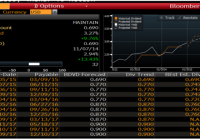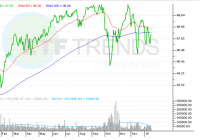Are Energy Stocks Finally A Buy?
Is this the time to buy a basket of energy stocks? Yes. Though, I should start by stating the obvious: We are awash in oil, and this market looks to be oversupplied for quite some time. On Thursday, the Energy Information Administration rattled energy stocks by reporting that U.S. crude inventories just saw their highest weekly jump in at least 14 years . Still, this is not the first time we’ve seen a bust in the oil patch. We will almost certainly see business failures as high-cost and highly indebted shale producers go belly-up. But the beauty of an ETF like the Energy Select Sector SPDR (NYSEARCA: XLE ) is that it is dominated by mega-cap supermajors and pipeline operators – the kinds of companies with the balance sheet strength to buy productive assets on the cheap, if we do see forced selling. Let’s take a look at the energy stocks that dominate XLE’s portfolio. Company Symbol % Assets Exxon Mobil Corporation (NYSE: XOM ) 16.63% Chevron Corporation (NYSE: CVX ) 13.63% Schlumberger N.V. (NYSE: SLB ) 7.22% Kinder Morgan, Inc. (NYSE: KMI ) 4.51% ConocoPhillips (NYSE: COP ) 3.95% EOG Resources, Inc. (NYSE: EOG ) 3.87% Occidental Petroleum (NYSE: OXY ) 3.43% Pioneer Natural Resources (NYSE: PXD ) 3.16% Anadarko Petroleum (NYSE: APC ) 3.06% Williams Companies, Inc. (NYSE: WMB ) 2.68% At the top of the list is, of course, that juggernaut of all oil supermajors, ExxonMobil Corp. Exxon accounts for 16.63% of XLE’s portfolio. Exxon will take its licks when it reports earnings. Consensus estimates have the company’s earnings dropping by about 29% when it reports. Yet, Exxon’s dividend is more than adequately covered, and it’s worth noting that it has raised its dividend for 32 consecutive years. Yes, even during the dark days of the 1980s and 1990s, when crude oil traded at generational lows, Exxon managed to keep growing its dividend. Furthermore, at 3.0%, this company is a relative high-yielder in a world in which the 10-year Treasury yields just 1.9%. Moving on, Chevron makes up another 13.63% of XLE’s portfolio. The company has raised its dividend for 27 consecutive years, and currently yields 3.9%. Like Exxon, Chevron’s dividend is more than adequately covered. The dividend payout ratios for Exxon and Chevron are 33% and 38%, respectively. There is a lot of room for crude oil prices to go lower before either of these stocks see their dividends at risk. Schlumberger takes the third spot, at 7.22%. As an oil services company rather than a supermajor, Schlumberger is riskier than Exxon or Chevron. As oil companies slash exploration, the service providers stand to absorb more of the loss in revenue. That’s ok. Schlumberger has lived through its share of both energy bull markets and bear markets, and it’s still here to tell the story. I wouldn’t aggressively buy Schlumberger as a standalone stock right now, but its 7.22% weighting here is more than acceptable. I really wish that Kinder Morgan Inc. gets a larger weighting than its current 4.51%. Kinder Morgan is one of the biggest and best-capitalized pipeline operators in the business, and I fully expect the company to go on a buying spree if some of its weaker competitors go bust. It’s worth noting that founder Richard Kinder started the company by buying unwanted pipeline assets from Enron for a song. Long after Enron bit the dust and became a byword for all that is wrong with corporate America, Mr. Kinder’s creation is going stronger than ever. Has the price of crude oil finally hit bottom? Probably not. But I’m ok with that. Energy stocks remain one of the few cheap sectors in an otherwise expensive market, and XLE provides a fine way to get exposure to the biggest and best. This article first appeared on Sizemore Insights as Are Energy Stocks Finally a Buy? Disclaimer: This article is for informational purposes only and should not be considered specific investment advice or as a solicitation to buy or sell any securities. Sizemore Capital personnel and clients will often have an interest in the securities mentioned. There is risk in any investment in traded securities, and all Sizemore Capital investment strategies have the possibility of loss. Past performance is no guarantee of future results.

